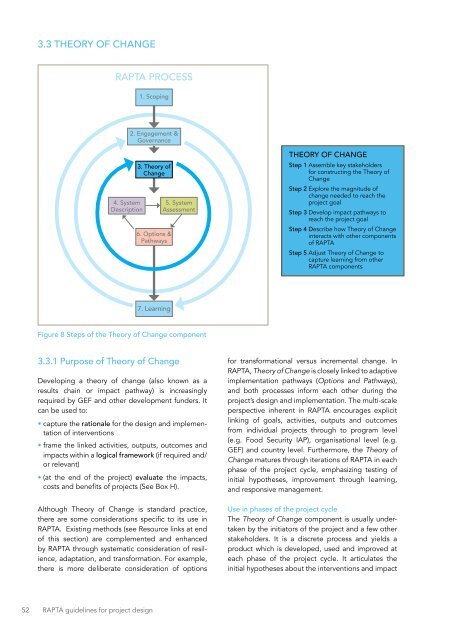DESIGNING PROJECTS IN A RAPIDLY CHANGING WORLD
srun3013fp1
srun3013fp1
Create successful ePaper yourself
Turn your PDF publications into a flip-book with our unique Google optimized e-Paper software.
3.3 THEORY OF CHANGE<br />
RAPTA PROCESS<br />
1. Scoping<br />
2. Engagement &<br />
Governance<br />
4. System<br />
Description<br />
3. Theory of<br />
Change<br />
6. Options &<br />
Pathways<br />
5. System<br />
Assessment<br />
THEORY OF CHANGE<br />
Step 1 Assemble key stakeholders<br />
for constructing the Theory of<br />
Change<br />
Step 2 Explore the magnitude of<br />
change needed to reach the<br />
project goal<br />
Step 3 Develop impact pathways to<br />
reach the project goal<br />
Step 4 Describe how Theory of Change<br />
interacts with other components<br />
of RAPTA<br />
Step 5 Adjust Theory of Change to<br />
capture learning from other<br />
RAPTA components<br />
7. Learning<br />
Figure 8 Steps of the Theory of Change component<br />
3.3.1 Purpose of Theory of Change<br />
Developing a theory of change (also known as a<br />
results chain or impact pathway) is increasingly<br />
required by GEF and other development funders. It<br />
can be used to:<br />
• capture the rationale for the design and implementation<br />
of interventions<br />
• frame the linked activities, outputs, outcomes and<br />
impacts within a logical framework (if required and/<br />
or relevant)<br />
• (at the end of the project) evaluate the impacts,<br />
costs and benefits of projects (See Box H).<br />
Although Theory of Change is standard practice,<br />
there are some considerations specific to its use in<br />
RAPTA. Existing methods (see Resource links at end<br />
of this section) are complemented and enhanced<br />
by RAPTA through systematic consideration of resilience,<br />
adaptation, and transformation. For example,<br />
there is more deliberate consideration of options<br />
for transformational versus incremental change. In<br />
RAPTA, Theory of Change is closely linked to adaptive<br />
implementation pathways (Options and Pathways),<br />
and both processes inform each other during the<br />
project’s design and implementation. The multi-scale<br />
perspective inherent in RAPTA encourages explicit<br />
linking of goals, activities, outputs and outcomes<br />
from individual projects through to program level<br />
(e.g. Food Security IAP), organisational level (e.g.<br />
GEF) and country level. Furthermore, the Theory of<br />
Change matures through iterations of RAPTA in each<br />
phase of the project cycle, emphasizing testing of<br />
initial hypotheses, improvement through learning,<br />
and responsive management.<br />
Use in phases of the project cycle<br />
The Theory of Change component is usually undertaken<br />
by the initiators of the project and a few other<br />
stakeholders. It is a discrete process and yields a<br />
product which is developed, used and improved at<br />
each phase of the project cycle. It articulates the<br />
initial hypotheses about the interventions and impact<br />
52 RAPTA guidelines for project design


